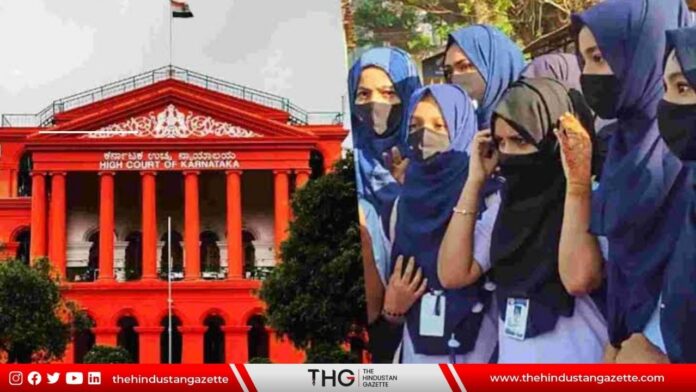The Karnataka High Court on Wednesday, continued to hear a batch of petitions filed by female Muslim students against ban on wearing hijab by several colleges across the state.
A full bench led by Chude Justice Ritu Raj Awasthi, Justice Krishna S Dixit and Justice J M Khazi heard the batch of petitions filed by Muslim girl students in Udupi who were barred from entering classes for wearing hijabs in alleged violation of uniforms prescribed by a college committee.

Professor and Senior Advocate Ravivarma Kumar appearing do the petitioners, referred to Rule 11 of the Education Rules, which says that institution should give one-year advance notice to parents for changing uniform. “If there was to be a ban on hijab, the notice ought to have been given one year in advance.”
He argued that the College Development Council is not an authority which is established or recognised under the rules. “he GO has declared that no uniform is prescribed for the PU colleges. But some colleges and management committees have imposed uniforms as mandatory, which is illegal. Prescription of any uniform is illegal. These are the guidelines issued by Govt Dept, namely PU Education Dept, for the academic year 2021-22”
He placed the document to show what the department itself has said – “an emphatic statement that no uniform is prescribed, that principal shall not insist on uniform and principal will face disciplinary action if uniform insisted.”

Neither the provisions under the act nor rules prescribe any uniform, he said adding that “Neither under act nor rules there is prohibition on wearing HIjab. There is no prohibition against Hijab.”
The senior advocate questioned “under what authority or rules I have been kept out of the class.”
Further reading the GO, he said “there is a direct indictment against those coming in hijab”.
Kumar submits that as per the GO, colleges coming under the jurisdiction of PU board, students shall wear the uniform as per CDC decision. “May I request the court to take the Education Act. Legislature has expressly authorized the authorities coming under the Act. I have already shown CDC is not an authority, much less a subordinate authority. So delegation cannot be made to it.”
Pointed out that CDC are constituted by a circular in 2014 and it’s not even an order, he said, “This is a circular, not an order, issued by the under secretary, not even an order in the name of the government.”
The circular says CDC is to be constituted for the purpose to utilise the grants, as well as maintain education standards. This CDC is not for students welfare. It is only for academic standards.

When Chief Justice Awasthi asked “Whether uniform can’t be prescribed to maintain academic standards?”
Kumar said that academic standards have no relation with unfirom. “Academic standards deal with student-teacher, syllabus etc. CDC cannot have police powers over the students.”
Referring to the composition of CDCs, which consists of MLAs, he asked “Can MLAs be treated as subordinate to the Govt?”
In our constitution, he argued that it is the representative of peoples who hold the govt accountable. “The hallmark of our democracy is holding the govt accountable by elected representatives. How can they be regarded as subordinate to govt?”
Observing that under the CDC, MLAs have taken over the administration, the counsel appearing for the Udupi girls said, “MLA cannot be entrusted with any administrative power. That is unknown in our Constitution, it violates the separation of powers.”
“Everything is wrong to give MLAs administrative powers. That will be a death knell to our democracy. MLAs are to be fearless in the floor of the house. They can’t be made subordinate to the Govt.”
Requesting the judges of take judicial note of the fact that an MLA will be representing a political party or a political ideology, Kumar questioned, “Can you entrust the welfare of the students to a political party or a political ideology?”
“I say the constitution of a committee of this nature gives a death blow to our democracy and separation of powers,” he said.
Kumar appealed that the order constituting CDC has to be ignored and the committee should not decide the welfare of the students and chuck them out of the classroom on one pretext or the other.
Further referring to a research paper based on a comprehensive survey done on religious clothes and symbols, he said, “Many Indians display the religion through attire. Half of Hindus and Muslims majority of Christians say they generally wear a religious pendant. Most Sikh men keep hair long”
“Most of the religious attire is gender-specific. 2/3rds of Muslim women say they wear a burkha. Half of more Hindus wear religious pendants. Most Hindu, Mulsim, Sikh women cover their head outside the home”, Kumar said while reading the paper.
He pointed out the fact that college going girls wear a dupatta, whether Hindu, Muslim or Christian.
“When there are 100s of symbols then why is the government picking on #Hijab. Bangles are worn…,” He argued before been interrupted by Justice Dixit.
“Unless the authenticity of paper is established we cannot go by what it says,” the Justice said.
In response, Kumar said, “I am only showing the vast diversity of religious symbols in all sections of the society. Why is Govt picking on hijab alone and making this hostile discrimination? Banlges are worn? Are they not religious symbols? Why are you picking on these poor Muslim girls?”
He mentioned the fact that it is only because only of the petioners religion they are being sent out of the classroom. “A bindi wearing girl is not sent out ,a bangle wearing girl is not. A Christian wearing cross is not touched. Why only these girls? This is violation of Art 15.”
“You are saying Article 15 prohibits discrimination on the basis of religion. But this saying wearing of the headdress of all religions is banned,” the justice noted.
“Hijab is worn only by Muslims. Ghoongats are permitted. Bangles are permitted. Why only this, why not the turban of a sikh, the cross of the Christians?” Kumar questioned.
He said Muslim girls are discriminated based on their religion.
“No other religious symbol is considered in the impugned GO. Why only hijab? Is it not because of their religion? Discrimination against Muslim girls is purely on the basis of religion and hence a hostile discrimination.”
Justice Dixit asked, “Even if a girl from another religion, who is suffering from acacia, and wears a headdres to cover her ugliness, will she be permitted?”
In response, Kumar said that se can apply for exemption. “That analogy may not be applicable here. It is a humanitarian case which will be considered.”
However, in the hijab ban case it is full of prejudice because of the religion, he noted, that “no notice was given and girls were straight away sent out of the classroom, by persons without authority under the Act or rules.”
“The goal of education is to promote plurality, not to promote uniformity or homogeneity, but heterogeneity. Classrom should be a place for recognition and reflection of diversity in society,” he adeed.
“Heterogeneity in classroom should be maintained. This is the motto of RTE Act’ – this was stated by Govt of India before SC in the Society of Unaided Schools case,” Kumar submitted.
He submitted that if people wearing turban can be in the Army, “why not a person sporting a religious symbol be allowed to attend classes.”
Concluding his final submissions, the senior advocate noted Muslim girls are least represented in classrooms. “If they are shut out on this pretext it will be very draconian.”



